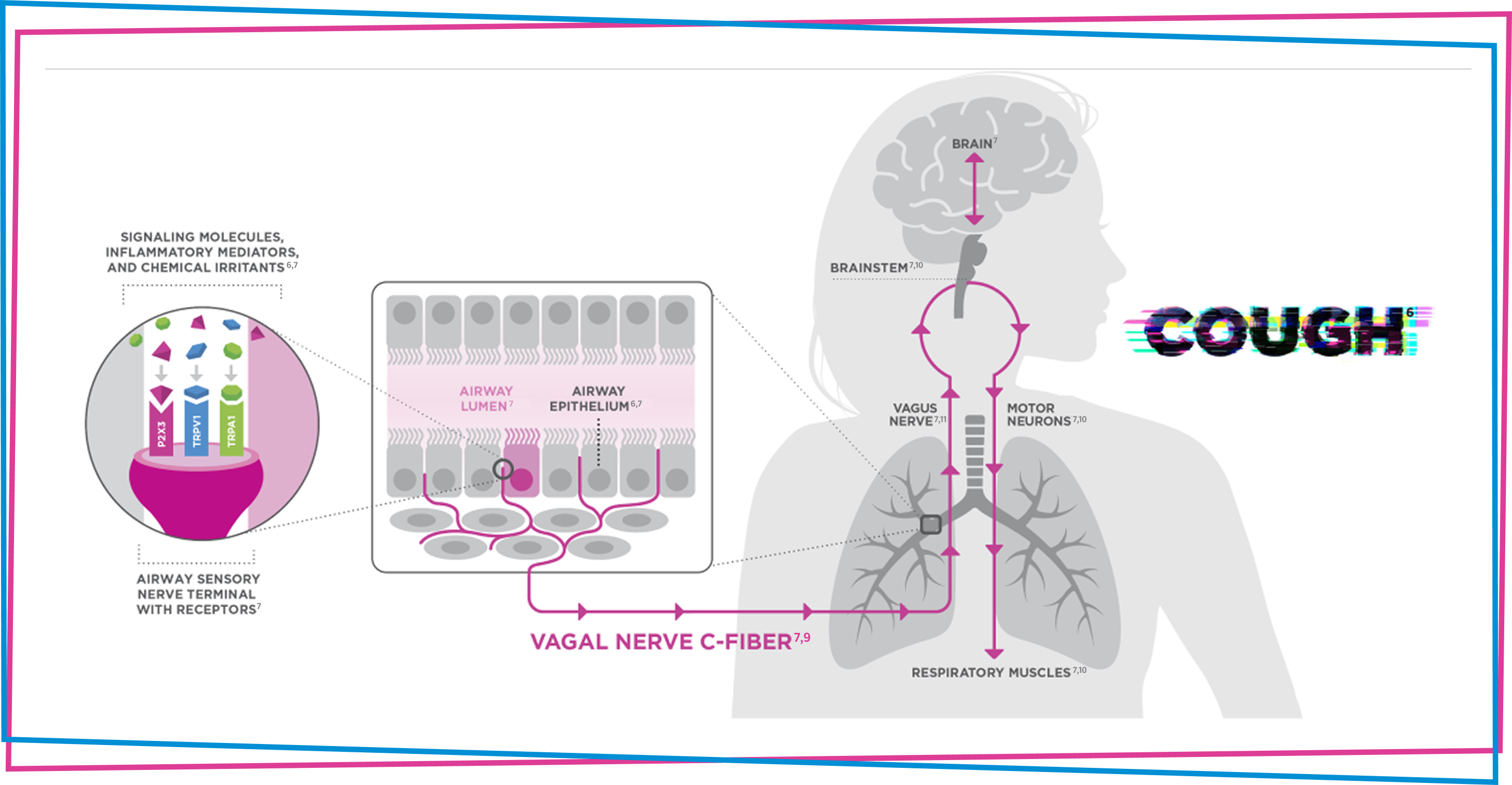Mechanism of disease
Mechanism of disease
Chronic cough is a multifaceted condition with several potential underlying mechanisms.1
If other causes of chronic cough are ruled out and refractory chronic cough or unexplained chronic cough (RCC) is suspected, it may be helpful to gain a better understanding of the mechanism of chronic cough and airway sensory nerve fibers. Research into the neurophysiology that may contribute to chronic cough has evolved, making it easier to understanding the mechanism.1,2
To better understand refractory and unexplained chronic cough, it is important to distinguish between the signaling pathways underlying the protective cough reflex and that of chronic cough.
Aδ-fibrer:
Myelinated, fast-conducting subepithelial nerves found in the proximal airways that respond to mechanical stimuli, or a rapid drop in airway pH. Aδ-fibres are important in clearing the airways of aspirated particles and initiating what can be considered a protective cough reflex.1,3,4,6,7
C-fibres:
Slower non-myelinated nerves in the airways that are characteristically sensitive to chemical irritants as well as stimuli such as heat, acid and inflammatory mediators. C-fibers can be activated in response to inflammation or tissue irritation.1,3,4,6,7

Both animal and human studies support the science used to illustrate the signaling pathways in this image. The clinical significance of animal data is not known.4,6
Signaling molecules (e.g. ATP), inflammatory mediators (e.g. PGE2) or chemical irritants (e.g. acrolein) may originate from airway cells or environmental sources.1,4,5,9,10
These substances, acting as ligands (e.g. ATP, PGE2 and acrolein) can activate the sensory receptors expressed on C-fibers.7,8,10
Cough signals are transmitted along the C-fibers of the vagus nerve and patients may show increased sensitivity to otherwise harmless cough triggers, such as cold air, strong odors or speech and laughter.2,3,4,5,7
Activation of these sensory C-fibers sends signals to the brainstem, which in turn sends signals to the respiratory muscles, resulting in a persistent cough.1,3,7
A protective cough reflex:4,7
- Helps to clear the airways of inhaled particles and aspirated gastric contents
- Is initiated in response to mechanical stimuli or drops in pH
- Is mediated by Aδ-fibres which are important for clearing the airways of aspirated particles
An unmet need in people with chronic cough:
- Chronic cough affects people worldwide, with approximately 10% overall global prevalence12,13
- Chronic cough may last for years, with median duration reported to be 2-5 years, according to an ELF survey11
- Chronic cough may affect patients’ QoL in the social, physical and psychological domains14
ELF survey: European Lung Foundation Survey; QoL: Quality of Life; ATP: adenosine triphosphate; P2X: purinoceptor; PGE2: prostaglandin E2; TRP: transient receptor potential channels
Click the following to learn more
References:
- Mazzone SB, Chung KF, McGarvey L. The heterogeneity of chronic cough: a case for the endotypes of cough hypersensitivity. Lancet Respir Med 2018;6(8):636–646.
- Morice AH, Millqvist E, Bieksiene K, et al. ERS guidelines on the diagnosis and treatment of chronic cough in adults and children. Eur Respir J 2020;55(1):1901136.
- Satia I, Badri H, Al-Sheklly B, Smith JA, Woodcock AA. Towards understanding and managing chronic cough. Clin Med (Lond) 2016;16(Suppl 6):s92–s97.
- Mazzone SB, Undem BJ. Vagal Afferent innervation of the airways in health and disease. Physiol Rev 2016;96:975–1024.
- Bonvini SJ, Belvisi MG. Cough and airway disease: the role of ion channels. Pulm Pharmacol Ther 2017;47:21–28.
- West PW, Canning BJ, Merlo-Pich E, Woodcock AA, Smith JA. Morphologic Characterization of Nerves in Whole-Mount Airway Biopsies. Am J Resp Crit Care Med 2015;192(1):30–39.
-
Canning BJ. Functional implications of the multiple afferent pathways regulating cough. Pulm
Pharmacol Ther 2011;24:295-299 - Irwin RS, French CL, Chang AB, Altman KW; CHEST Expert Cough Panel. Classification of cough as a symptom in adults and management algorithms: CHEST guideline and expert panel report. Chest 2018;153(1):196–209.
- Belvisi MG, Birrell MA. The emerging role of transient receptor potential channels in chronic lung disease. Eur Respir J 2017;50(2):1601357.
- Li M, Wang Y, Banerjee R, et al. Molecular mechanisms of human P2X3 receptor channel activation and modulation by divalent cation bound ATP. Elife 2019;8:e47060.
- Chamberlain SAF, et al. The impact of chronic cough: a cross-sectional European survey. Lung 2015;193:401–408.
- Song WJ, et al. The global epidemiology of chronic cough in adults: a systematic review and meta-analysis. Eur Respir J 2015;45:1479–1481.
- Mazzone SB, McGarvey L. Mechanisms and Rationale for Targeted Therapies in Refractory and Unexplained Chronic Cough. Clin Pharmacol Therapeut 2020. E-publicerat före tryckning. Doi: 10.1002/cpt.2003.
- French CL, Crawford SL, Bova C, Irwin RS. Change in Psychological, Physiological, and Situational Factors in Adults After Treatment of Chronic Cough. CHEST 2017;152(3):547–562.

